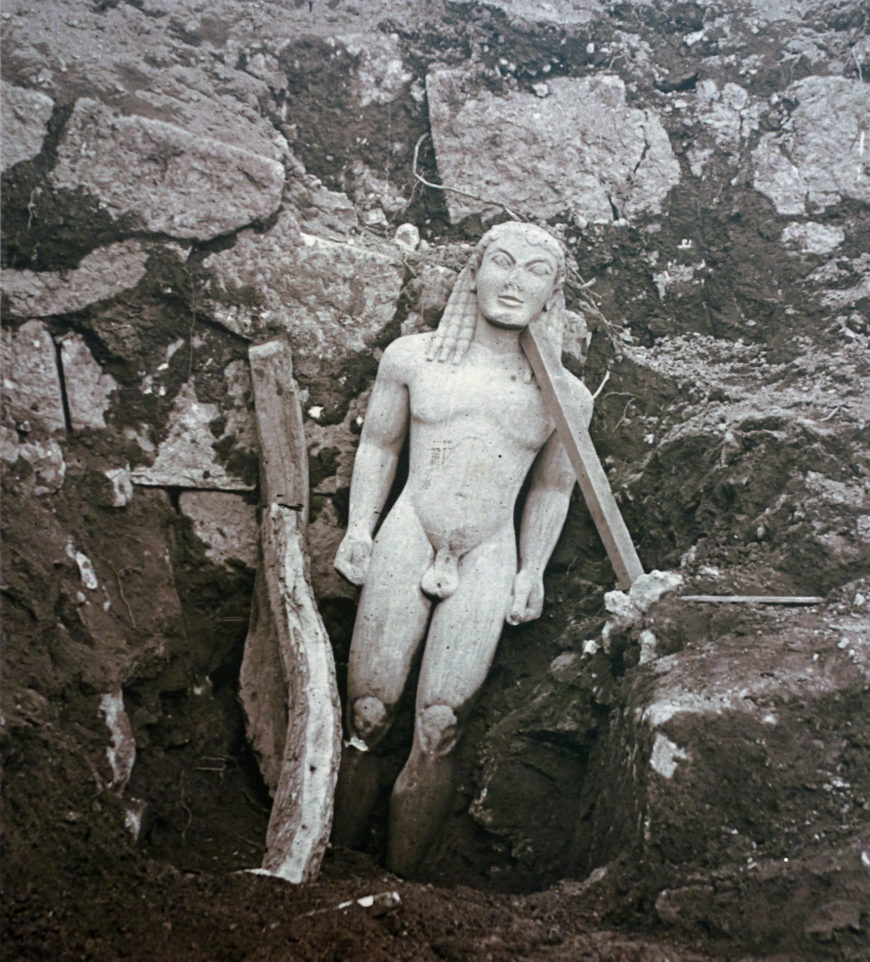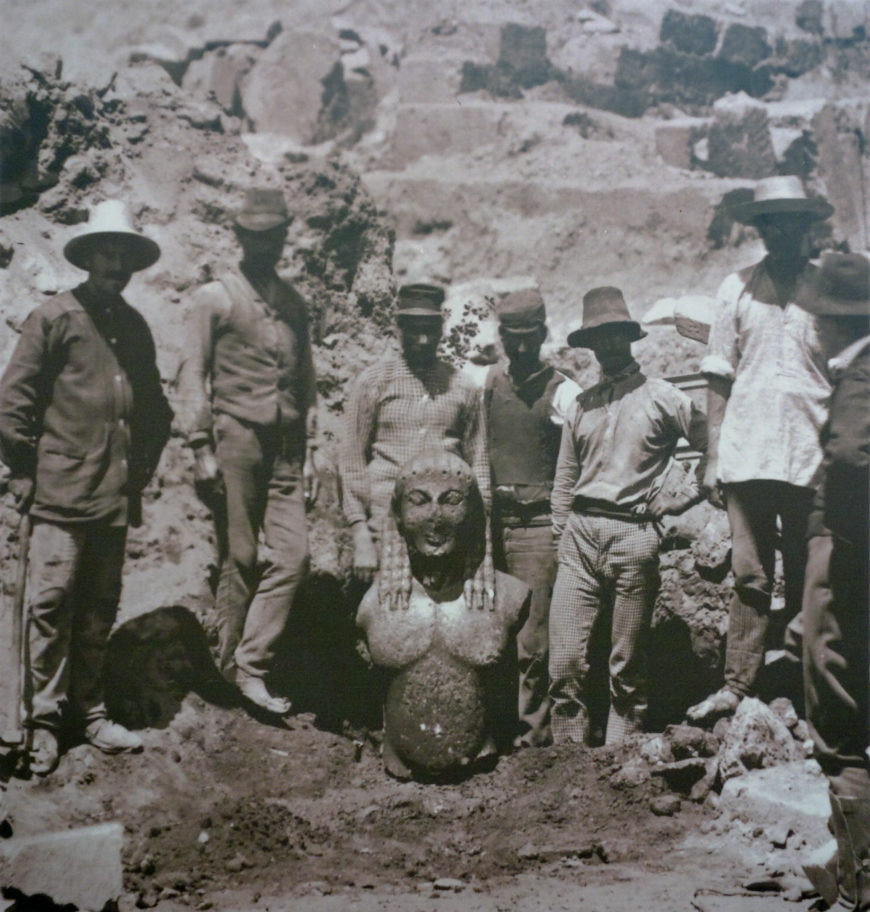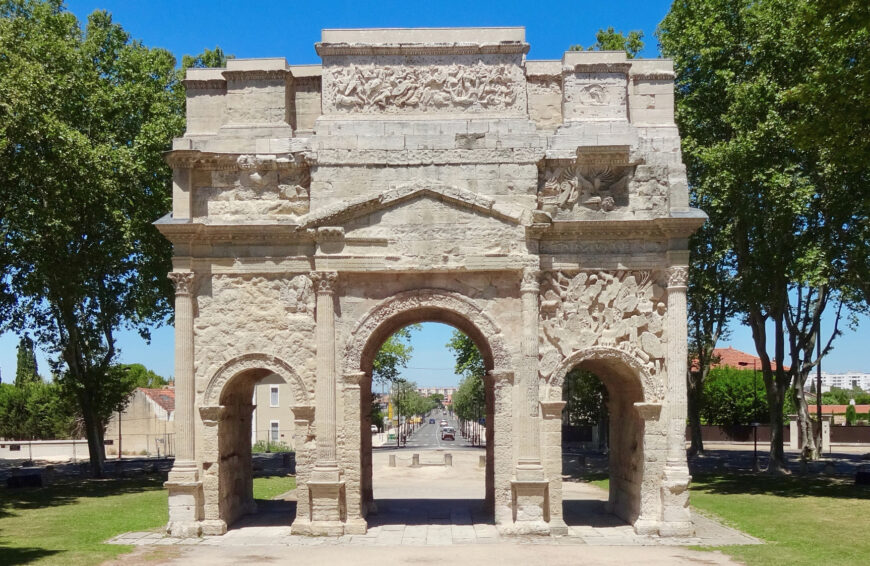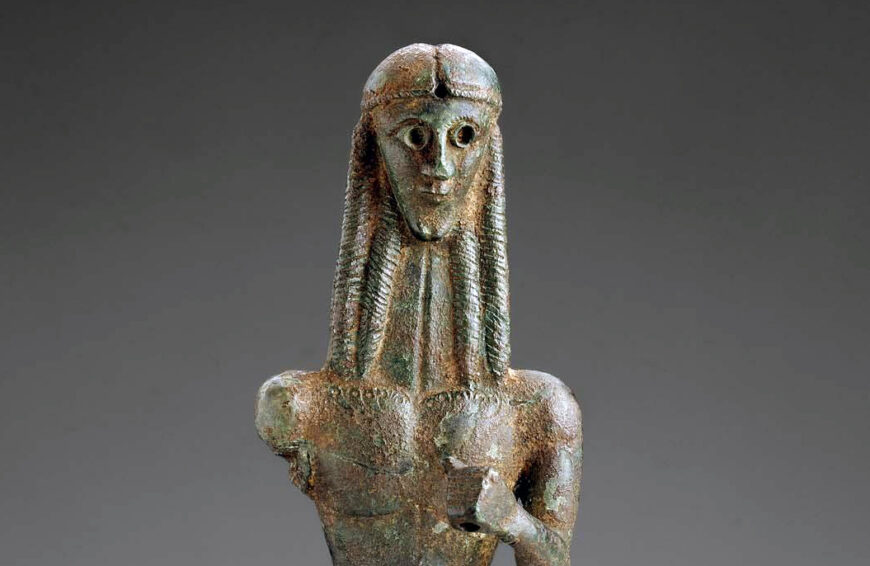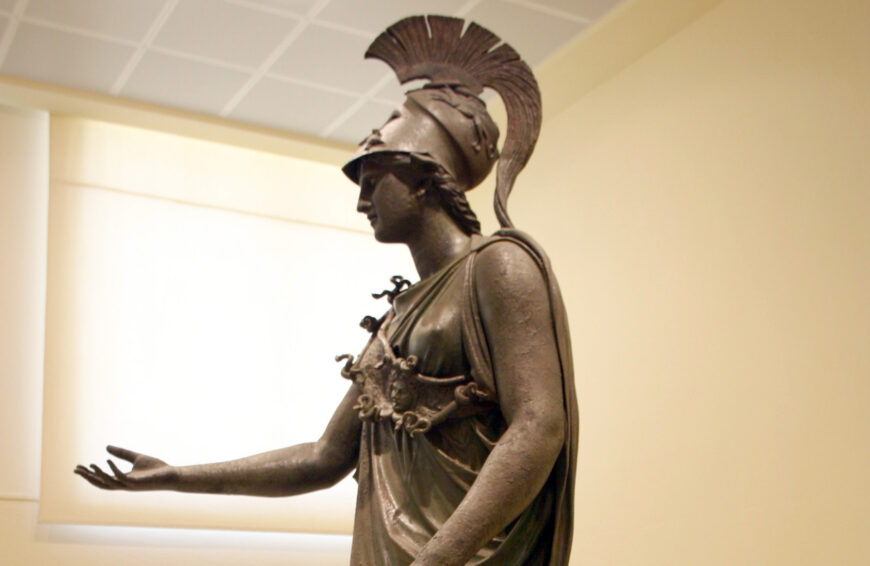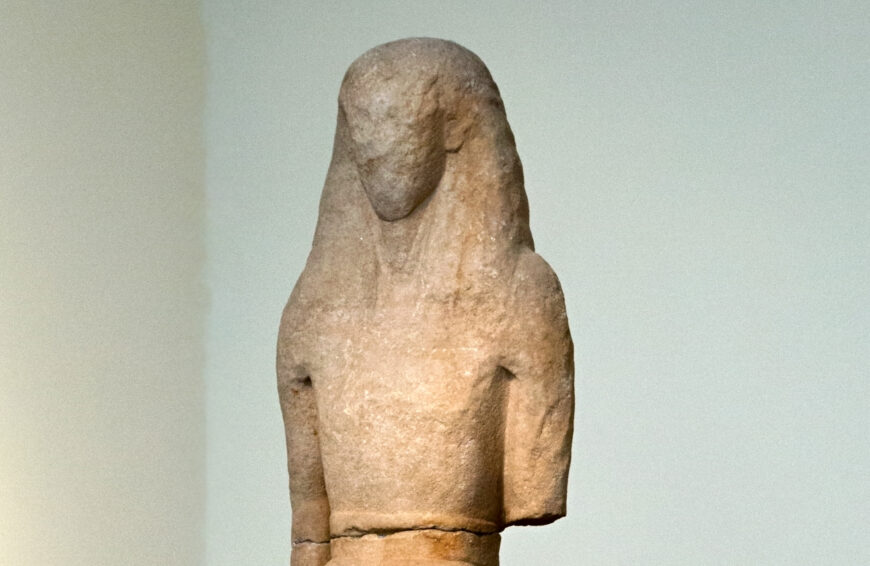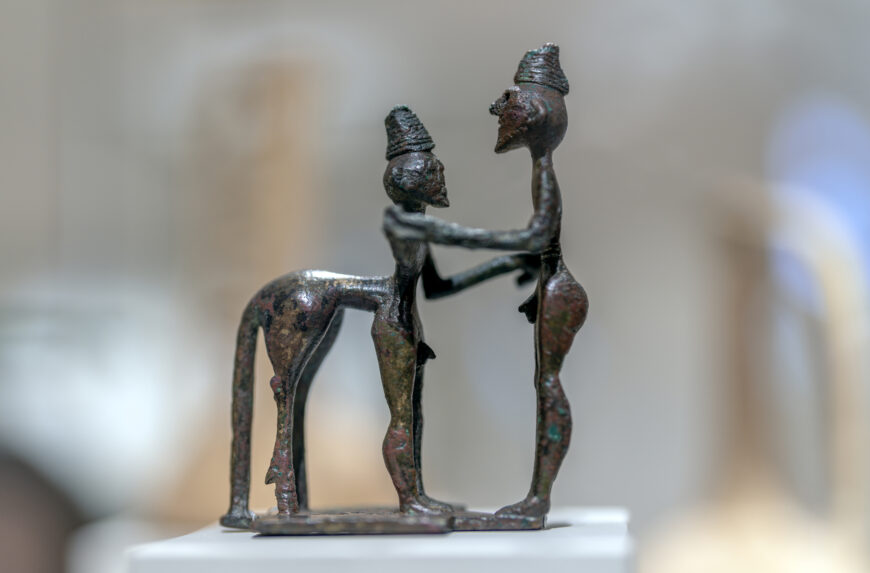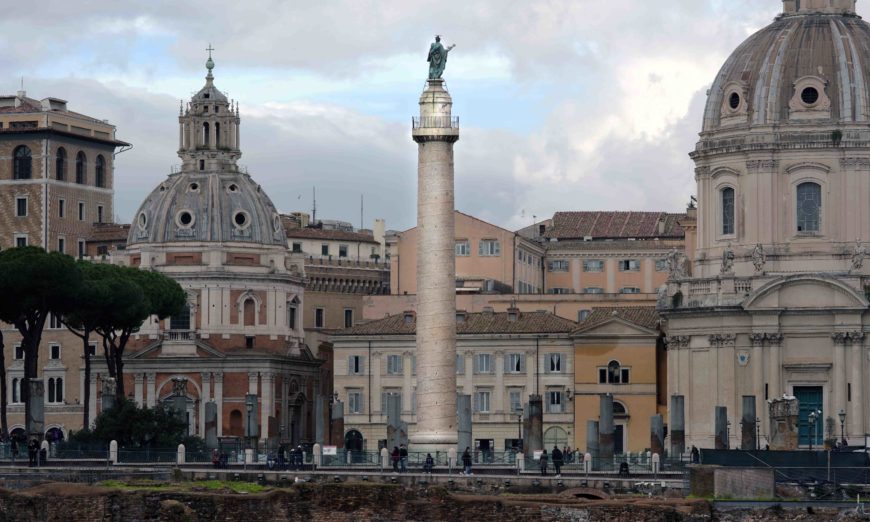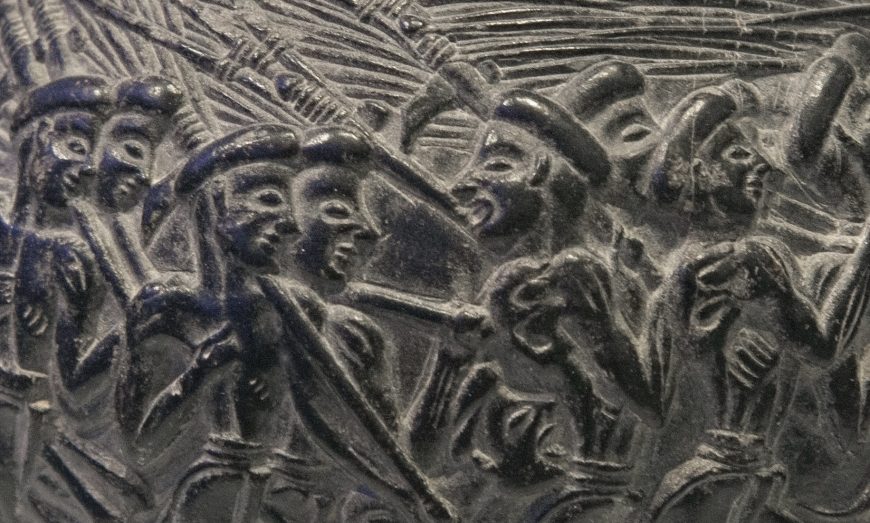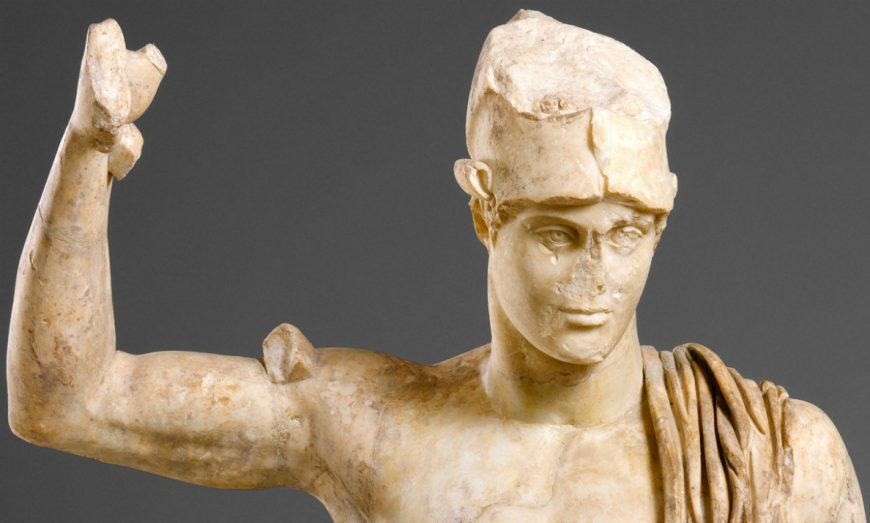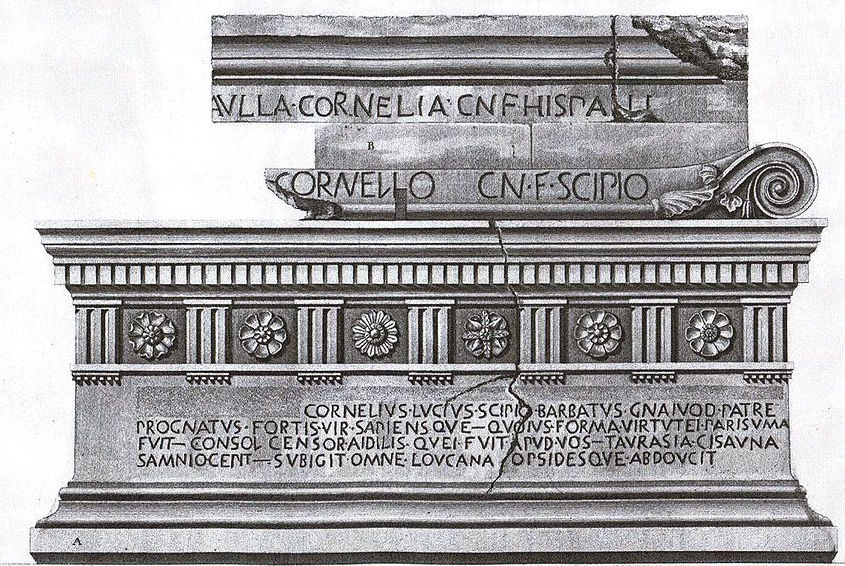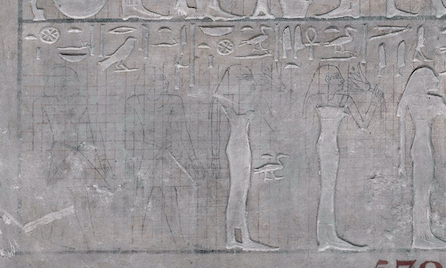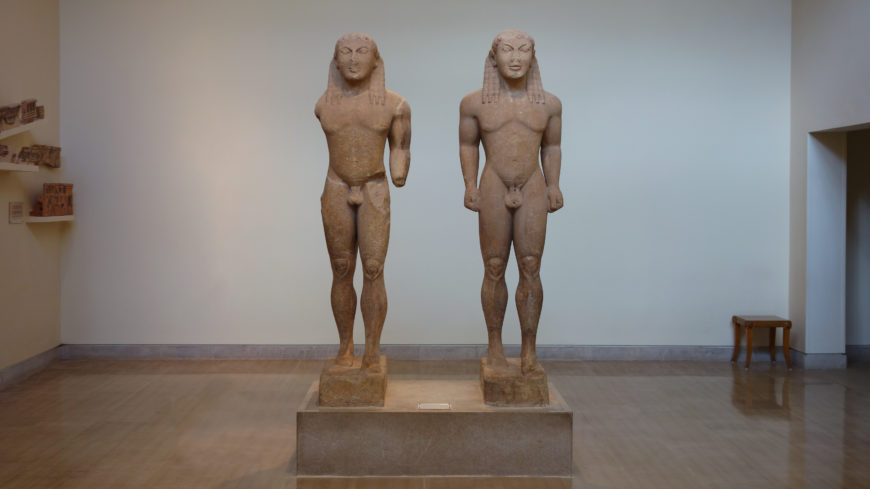
[Poly?]medes of Argos, kouroi of Kleobis and Biton, early 6th century B.C.E., found at the sanctuary of Apollo, Delphi, Greece (Delphi Archaeological Museum; photo: Steven Zucker, CC BY-NC-SA 2.0)
In one of his memorable anecdotes, the ancient Greek historian Herodotus recounts the events of a fateful day in the city-state of Argos (on the Peloponnesian Peninsula). A priestess of the goddess Hera found herself unable to get to an important religious festival because her oxen were still out plowing the fields, too busy to pull her and her cart to the temple. Improvising quickly, the woman’s two sons Kleobis and Biton strapped themselves to their mother’s cart and pulled her more than 5 miles to the sacred site. Everyone at the temple praised the young men, and their mother asked Hera to give her sons the best gift they could receive. That night, after the religious festivities, Kleobis and Biton went to sleep in the temple of Hera and died peacefully. Herodotus explains that death was the greatest gift the goddess could give them: they died in their prime, surrounded by the praise and love of their family and fellow citizens, who would honor their memory forever. At the end of this tale, Herodotus writes that “the Argives made and set up at Delphi images of them [Kleobis and Biton] because of their excellence.” [1] In the early 1890s, archaeologists believed they found these very images.
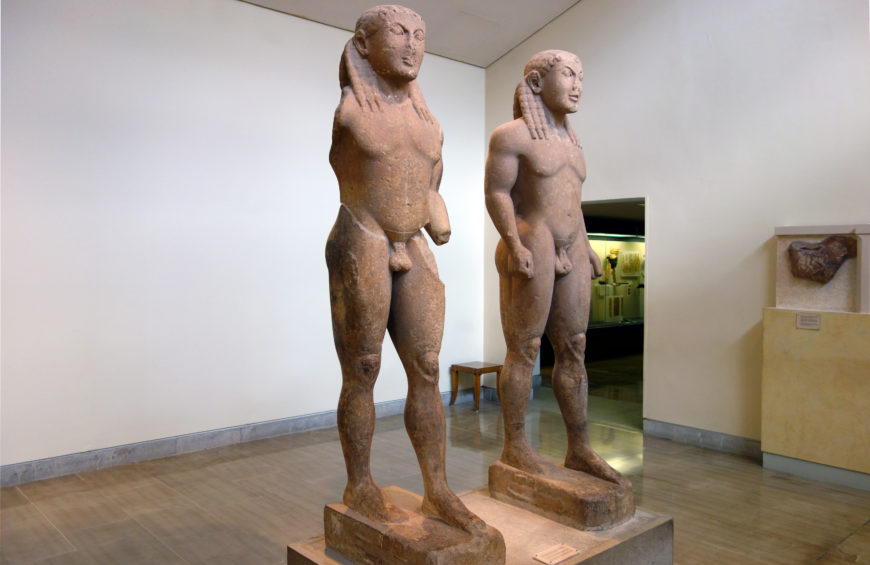
[Poly?]medes of Argos, kouroi of Kleobis and Biton, early 6th century B.C.E., found at the sanctuary of Apollo, Delphi, Greece (Delphi Archaeological Museum; photo: Steven Zucker, CC BY-NC-SA 2.0)
Recognizing Kleobis and Biton
In 1893 and 1894 French archaeologists uncovered two extremely similar kouroi (statues of idealized nude male youths that functioned as grave markers or offerings to the gods) while excavating the sanctuary of Apollo at Delphi. At first glance, the pair appear to be typical examples of the kouros type. Like other kouroi, they were erected in a sanctuary, where they functioned as both commemorative monuments and gifts to the gods.
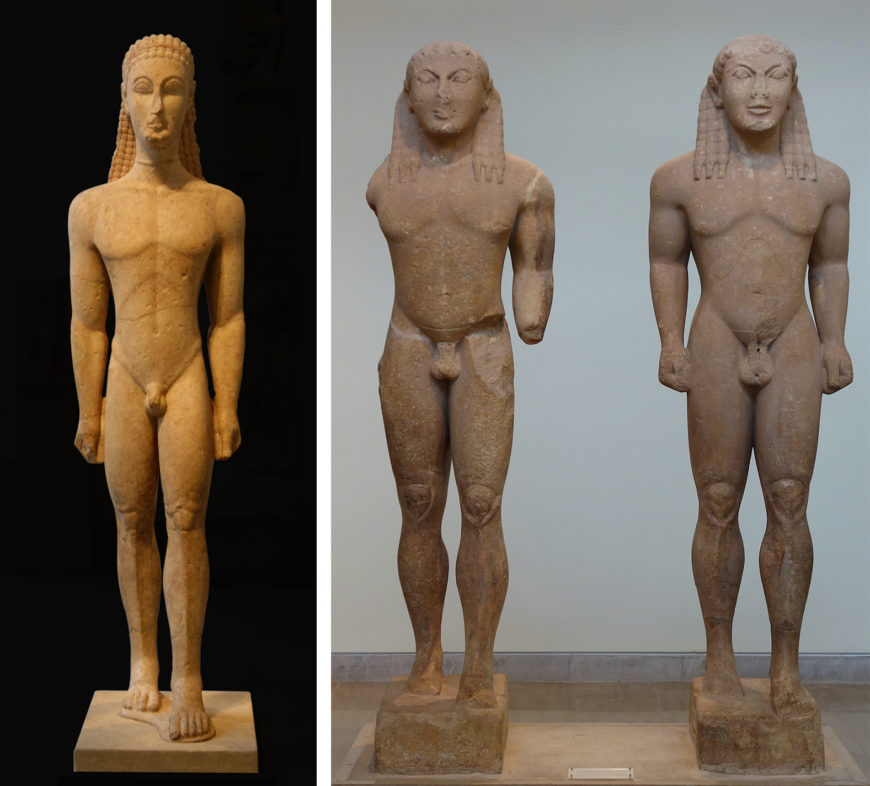
Left: Marble Statue of a Kouros (New York Kouros), c. 590–580 B.C.E. (Attic, archaic), Naxian marble, 194.6 x 51.6 cm (The Metropolitan Museum of Art; photo: Steven Zucker, CC BY-NC-SA 2.0); right: [Poly?]medes of Argos, kouroi of Kleobis and Biton, early 6th century B.C.E., found at the sanctuary of Apollo, Delphi, Greece (Delphi Archaeological Museum; photo: Steven Zucker, CC BY-NC-SA 2.0)
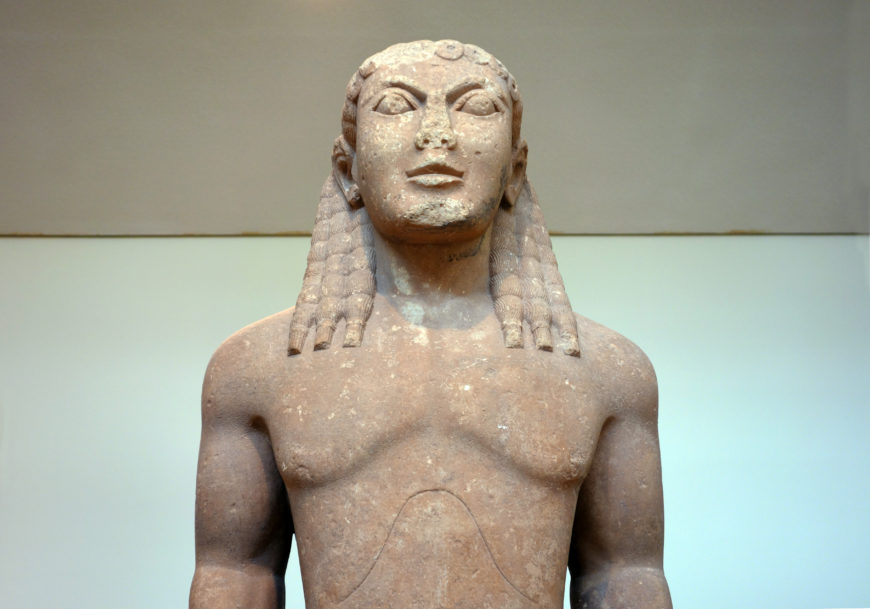
[Poly?]medes of Argos, kouros of Biton, early 6th century B.C.E., found at the sanctuary of Apollo, Delphi, Greece (Delphi Archaeological Museum; photo: Steven Zucker, CC BY-NC-SA 2.0) (photo: Steven Zucker, CC BY-NC-SA 2.0)
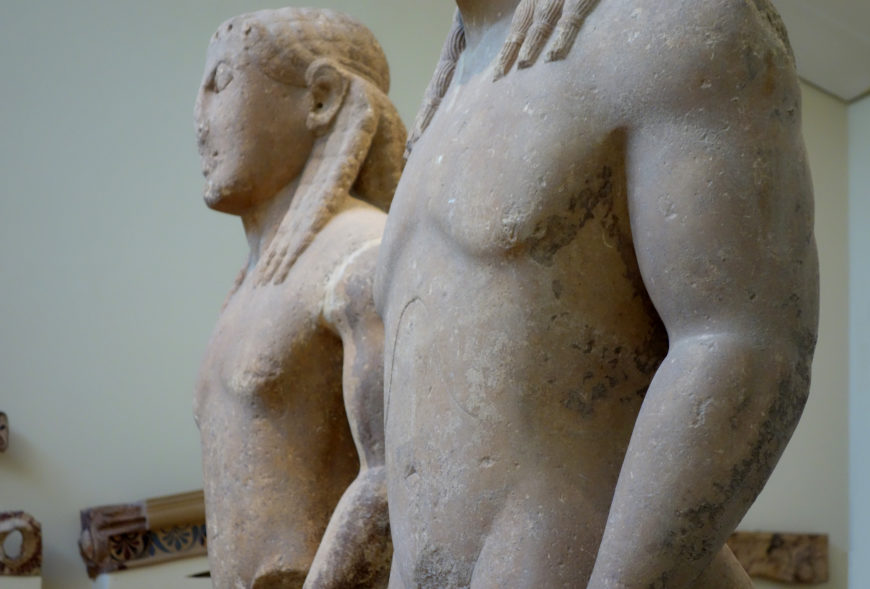
[Poly?]medes of Argos, kouroi of Kleobis and Biton (Delphi Archaeological Museum; photo: Steven Zucker, CC BY-NC-SA 2.0)
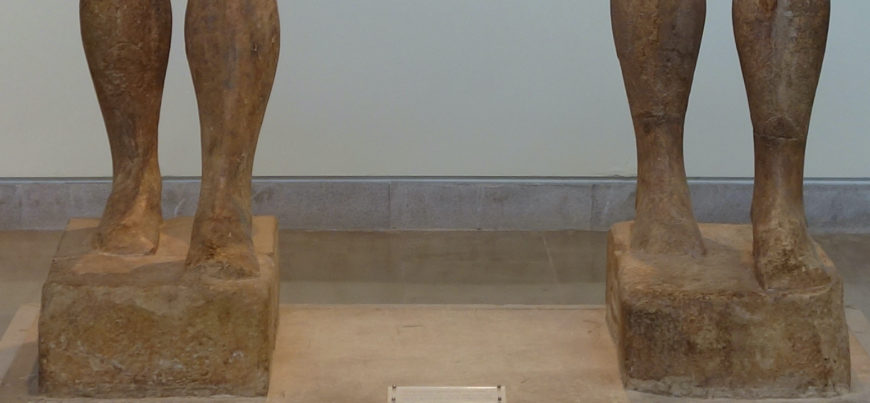
[Poly?]medes of Argos, kouroi of Kleobis and Biton, early 6th century B.C.E., found at the sanctuary of Apollo, Delphi, Greece (Delphi Archaeological Museum; photo: Steven Zucker, CC BY-NC-SA 2.0)
Decoding Inscriptions
All of these visual indicators suggest that the pair of kouroi from Delphi represent Kleobis and Biton. However, like other kouroi, the statues are so idealized that they probably do not closely resemble the people they represent. Rather than being honored with realistic portraits, men who were commemorated with kouroi forever projected a perfectly idealized image to those who walked by their monuments.
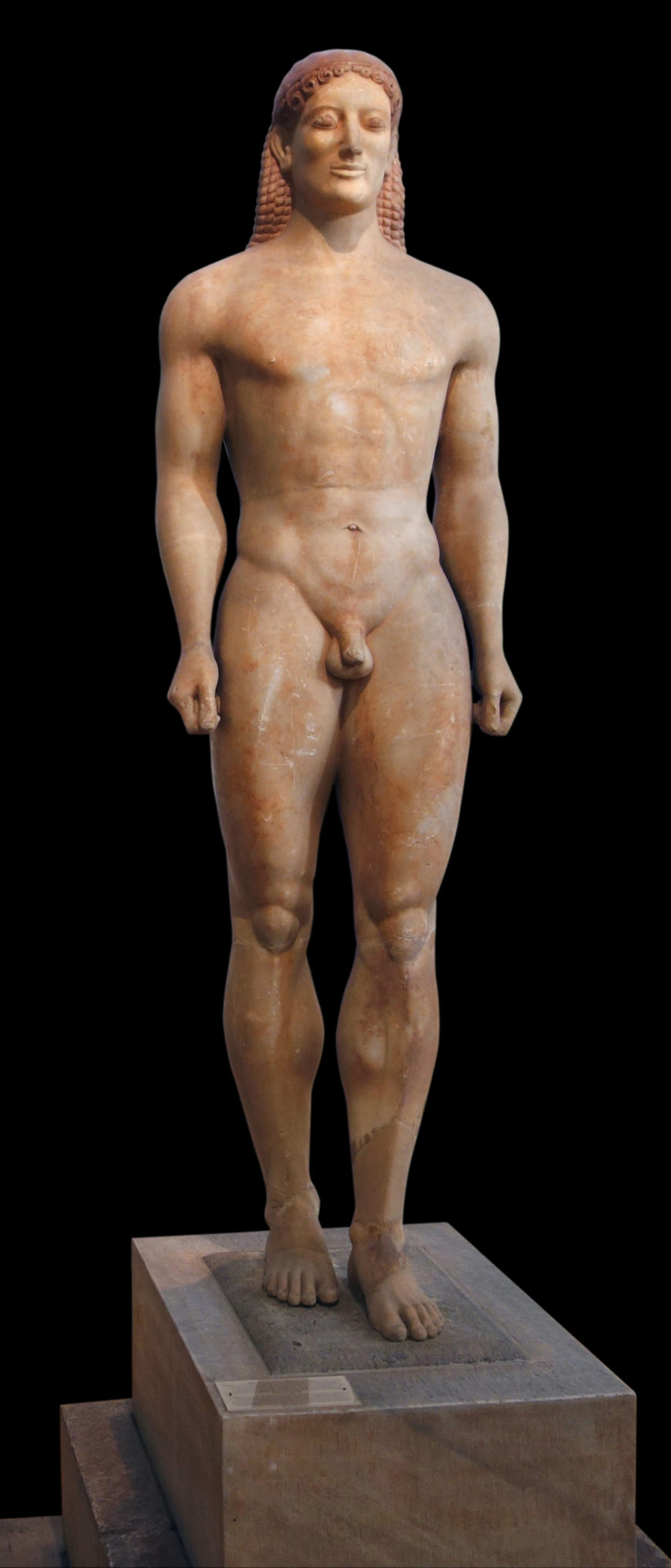
Anavysos Kouros, c. 530 B.C.E., marble, 6′ 4″ (National Archaeological Museum, Athens; photo: Steven Zucker, CC BY-NC-SA 2.0)
Generally, the man honored by a kouros was not identifiable by the statue itself, but by an inscription that accompanied the statue on its base. As a result, only kouroi that are found with their inscribed bases in modern excavations can be identified with any certainty. This is the case with the Anavysos Kouros, the base of which tells us that the statue was dedicated for a soldier named Kroisos.

[Poly?]medes of Argos, kouroi of Kleobis and Biton, early 6th century B.C.E., found at the sanctuary of Apollo, Delphi, Greece (Delphi Archaeological Museum; photo: Steven Zucker, CC BY-NC-SA 2.0)
However, the re-identification of the kouroi as Castor and Pollux rather than Kleobis and Biton has been discouraged by recent scientific analysis of the surviving inscriptions. This study has shown that only a few words on one of the plinths are preserved well enough to be read with any certainty. [4] The text does not indicate that the kouroi represent Castor and Pollux, but instead tells us the name of the artist who made them. Translated into English, the words mean “[Poly?]medes the Argive made it.” While the artist’s name is partially lost, he is described as Argive, which seems to further support an identification of these two kouroi as the Argive brothers Kleobis and Biton. Even so, the extreme idealization of this pair of kouroi makes them appear to be almost super-human, and their original viewers may have also been reminded of the divine Dioscuri when they looked at these images. [5]
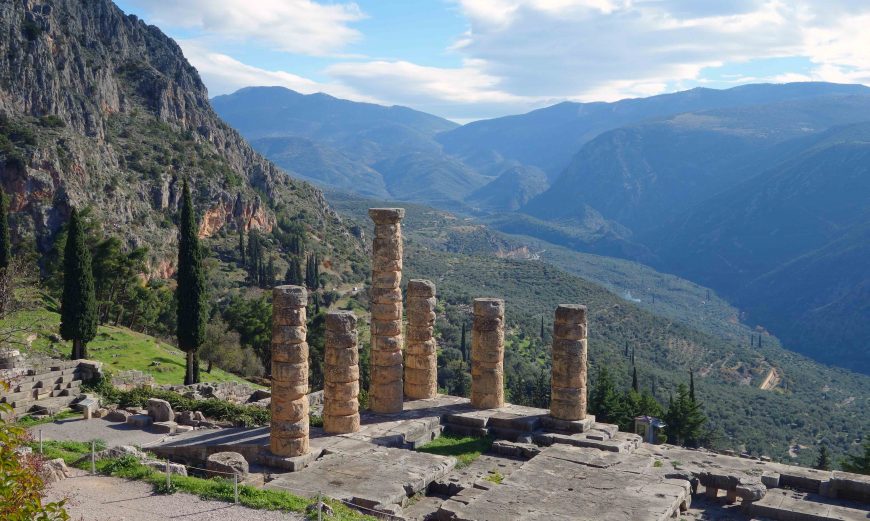
Temple of Apollo (with reconstructed columns), Sanctuary of Apollo, Delphi, Greece (photo: Steven Zucker, CC BY-NC-SA 2.0)
Preserving Memories with Images
In the midst of the sanctuary of Apollo at Delphi, which was believed to be the center of the ancient Greek world, and was visited by pilgrims from hundreds of miles away, the kouroi of Kleobis and Biton drew attention to themselves. Standing more than 6’ tall, these statues had a commanding presence that would encourage passersby to stop and look at their images. These ancient visitors may have read the inscriptions on the statues’ plinths to learn their story. Having died as heroes in their youth, Kleobis and Biton achieved a sort of immortality through these images. By erecting this pair of kouroi in the sanctuary of Apollo at Delphi, the Argive people made the memory of Kleobis and Biton permanent, ensuring that visitors to Delphi would forever be impressed by the brothers’ excellence.


